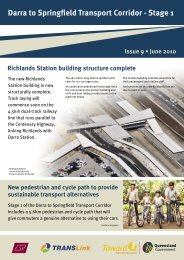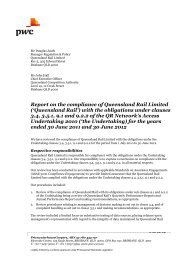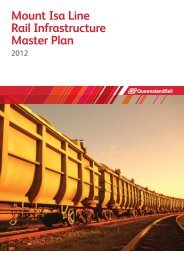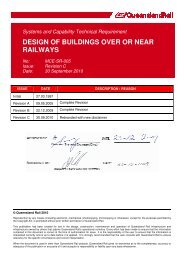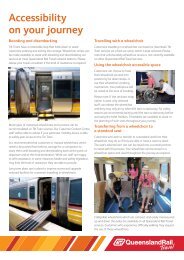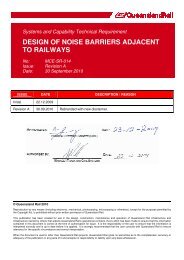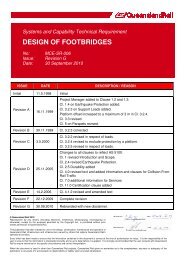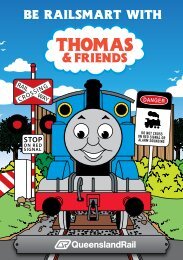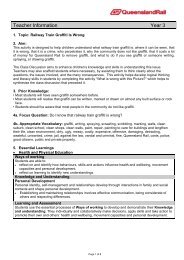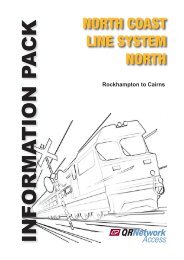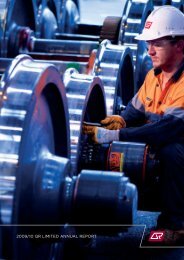work adjacent to overhead line equipment - Queensland Rail
work adjacent to overhead line equipment - Queensland Rail
work adjacent to overhead line equipment - Queensland Rail
You also want an ePaper? Increase the reach of your titles
YUMPU automatically turns print PDFs into web optimized ePapers that Google loves.
Systems and Capability Technical Requirement<br />
WORK ADJACENT TO OVERHEAD LINE<br />
EQUIPMENT<br />
No: MCE-SR-003<br />
Issue: Revision E<br />
Date: 30 September 2010<br />
ISSUE DATE DESCRIPTION / REASON<br />
Initial 07.08.1997<br />
Revision A 16.01.2001<br />
Reference made <strong>to</strong> Electrification Manual (STD/0039/SWK)<br />
QUEENSLAND RAIL costs updated<br />
Revision B 04.02.2002 Safety Induction Course cost updated<br />
Revision C 30.06.2005<br />
Revision D 22.12.2009 Complete Revision<br />
Cl. 3.2.2 revised in respect of loads.<br />
Cl. 3.2.4 revised <strong>to</strong> exclude protection by a platform.<br />
Cl. 3.2.5 revised in respect of loads.<br />
Revision E 30.09.2010 Rebranded with new disclaimer.<br />
© <strong>Queensland</strong> <strong>Rail</strong> 2010<br />
Reproduction by any means (including electronic, mechanical, pho<strong>to</strong>copying, microcopying or otherwise), except for the purposes permitted by<br />
the Copyright Act, is prohibited without prior written permission of <strong>Queensland</strong> <strong>Rail</strong>.<br />
This publication has been created for use in the design, construction, maintenance and operation of <strong>Queensland</strong> <strong>Rail</strong> infrastructure and<br />
infrastructure owned by others that adjoins <strong>Queensland</strong> <strong>Rail</strong>'s operational corridors. Every effort has been made <strong>to</strong> ensure that the information<br />
contained in this document is correct at the time of authorisation for issue. It is the responsibility of the user <strong>to</strong> ensure that the information is<br />
interpreted correctly and is up <strong>to</strong> date before it is applied. It is strongly recommended that the user consults with <strong>Queensland</strong> <strong>Rail</strong> <strong>to</strong> ensure<br />
relevancy for the specific circumstance and correct interpretation.<br />
When the document is used in other than <strong>Queensland</strong> <strong>Rail</strong> projects, <strong>Queensland</strong> <strong>Rail</strong> gives no warranties as <strong>to</strong> the completeness; accuracy or<br />
adequacy of the publication or any parts of it and accepts no responsibility or liability upon any basis whatsoever.
WORK ADJACENT TO OVERHEAD LINE EQUIPMENT, Revision E<br />
Contents Page<br />
1.0 INTRODUCTION...........................................................................................................................3<br />
2.0 SCOPE.........................................................................................................................................3<br />
3.0 WORK ADJACENT TO OVERHEAD TRACTION WIRING EQUIPMENT .....................................3<br />
3.1 Warning ....................................................................................................................................3<br />
3.2 General Requirements..............................................................................................................4<br />
3.3 Application Procedure...............................................................................................................4<br />
4.0 FURTHER INFORMATION...........................................................................................................4<br />
Page 2 of 4
WORK ADJACENT TO OVERHEAD LINE EQUIPMENT, Revision E<br />
1.0 INTRODUCTION<br />
This Technical Requirement details the criteria<br />
which must be met by an external party <strong>work</strong>ing<br />
<strong>adjacent</strong> <strong>to</strong> Overhead Traction Wiring<br />
Equipment, in or about <strong>Queensland</strong> <strong>Rail</strong><br />
property.<br />
Definition:<br />
Electrified Area is any section of track<br />
equipped with <strong>overhead</strong> traction wiring<br />
<strong>equipment</strong>, or any substation or supply<br />
substation used <strong>to</strong> provide power for electric<br />
trains.<br />
Overhead Traction Power Equipment is the<br />
structures and <strong>overhead</strong> <strong>equipment</strong> necessary<br />
for the traction power supply for electric trains.<br />
Traction Power Engineer or delegated<br />
representative is the registered professional<br />
electrical engineer responsible for the electric<br />
traction infrastructure in a defined geographic<br />
area in respect of 1. System operation,<br />
maintenance and integrity; and 2. Electrical<br />
safety advice.<br />
Isolation is the action or arrangement whereby<br />
an electrical section of the <strong>overhead</strong> traction<br />
power <strong>equipment</strong> is isolated from all possible<br />
sources of electrical supply and earthed so that<br />
the <strong>equipment</strong> is no longer energised with<br />
electricity at the <strong>work</strong> site.<br />
Permit <strong>to</strong> Work (Form C) is a permit that is<br />
issued subsequent <strong>to</strong> the <strong>equipment</strong> being<br />
isolated and earthed.<br />
Safety Clarification Advice (SCA) is a written<br />
advice provided by QUEENSLAND RAIL on how<br />
<strong>to</strong> safely carry out <strong>work</strong> that has the potential <strong>to</strong><br />
come within the 3 m exclusion zone of the live<br />
<strong>overhead</strong> traction power <strong>equipment</strong>. It is site<br />
specific written advice, concerning <strong>work</strong><br />
restrictions in the vicinity of live <strong>overhead</strong><br />
traction power <strong>equipment</strong>. This advice is<br />
supplied by the Senior Traction Power Engineer<br />
or their representative in response <strong>to</strong> a request<br />
from a Person in Charge of Work.<br />
Person in Charge of Work (PICOW) is a<br />
<strong>work</strong>er who has the competence <strong>to</strong> supervise<br />
the electrical safety aspects of the <strong>work</strong> and has<br />
been appointed by <strong>line</strong> management <strong>to</strong> take<br />
charge of a specific <strong>work</strong>site in the electrified<br />
area. If this <strong>work</strong>er is not the <strong>work</strong>er supervising<br />
the technical aspects of the <strong>work</strong> or is not the<br />
<strong>work</strong> group leader, then the<br />
PICOW must be given an overriding safety<br />
responsibility.<br />
Reference is made <strong>to</strong> the following additional<br />
<strong>Queensland</strong> <strong>Rail</strong> Technical Requirements which<br />
must also be satisfied:<br />
MCE-SR-001 Design of road overbridges;<br />
MCE-SR-002 Work in or about <strong>Queensland</strong> <strong>Rail</strong><br />
property,<br />
MCE-SR-005 Design of buildings over or near<br />
railways,<br />
MCE-SR-006 Design of footbridges;<br />
MCE-SR-008 Protection screens, and<br />
MCE-SR-012 Protection of supporting elements<br />
<strong>adjacent</strong> <strong>to</strong> railways.<br />
Copies of these documents may be obtained<br />
from <strong>Queensland</strong> <strong>Rail</strong>.<br />
All reference documents, e.g. Australian<br />
Standards, codes and <strong>Queensland</strong> <strong>Rail</strong><br />
Technical Requirements, are <strong>to</strong> be the latest<br />
version.<br />
2.0 SCOPE<br />
This Technical Requirement specifies the<br />
requirements that a Contrac<strong>to</strong>r, not <strong>work</strong>ing for<br />
<strong>Queensland</strong> <strong>Rail</strong>, must comply with when<br />
<strong>work</strong>ing:<br />
• On <strong>Queensland</strong> <strong>Rail</strong> Property,<br />
• In the vicinity of <strong>Queensland</strong> <strong>Rail</strong> property,<br />
or<br />
• Over or under <strong>Queensland</strong> <strong>Rail</strong> property.<br />
3.0 WORK ADJACENT TO OVERHEAD<br />
TRACTION WIRING EQUIPMENT<br />
3.1 Warning<br />
WARNING: None of the components of the<br />
Overhead Line Equipment have any protective<br />
covering and are potentially dangerous and shall<br />
not be approached by persons either directly or<br />
indirectly with any item of material or <strong>equipment</strong>.<br />
A 3 m exclusion zone from Overhead Electrics<br />
must be maintained.<br />
All <strong>overhead</strong> <strong>line</strong> <strong>equipment</strong> shall always be<br />
regarded as energised with 25,000 volts of<br />
electricity unless an isolation has been carried<br />
out and a Permit <strong>to</strong> Work has been issued.<br />
Page 3 of 4
WORK ADJACENT TO OVERHEAD LINE EQUIPMENT, Revision E<br />
If, in the opinion of a Track Protection Officer<br />
(TPO) or the Track Protection Coordina<strong>to</strong>r<br />
(TPC), any activity of the Contrac<strong>to</strong>r is<br />
considered dangerous or contravenes any of<br />
these Requirements, then the TPO or TPC has<br />
the authority <strong>to</strong> direct that such activity is <strong>to</strong><br />
cease immediately.<br />
3.2 General Requirements<br />
For any <strong>work</strong> <strong>adjacent</strong> <strong>to</strong> Overhead Traction<br />
Wiring Equipment that encroaches or has the<br />
potential <strong>to</strong> encroach within 3 m of the Overhead<br />
Traction Wiring Equipment from a position<br />
below, along side or for any <strong>work</strong> at any<br />
distance above, no <strong>work</strong> shall commence on<br />
site until the Contrac<strong>to</strong>r has contacted the<br />
Senior Traction Power Engineer’s office and<br />
received one of the following :<br />
An isolation of the Overhead Traction Wiring<br />
and receipt of a Permit <strong>to</strong> Work (Form C) issued<br />
from a nominated person.<br />
A Safety Clarification Advice (SCA) issued by<br />
the Senior Traction Power Engineer or his<br />
designated representative.<br />
Isolation and Permit <strong>to</strong> Work :<br />
When the Senior Traction Power Engineer<br />
(STPE) determines that <strong>work</strong> cannot be carried<br />
out safely under a Safety Clarification Advice<br />
(SCA) process, an isolation must be sought and<br />
planned so that the <strong>work</strong> can be conducted<br />
safely. A Permit <strong>to</strong> Work (Form C) will allow<br />
suitably trained <strong>work</strong>ers under the supervision of<br />
a Person In Charge of Work (PICOW), <strong>to</strong> <strong>work</strong><br />
“NEAR” isolated <strong>overhead</strong> <strong>line</strong> <strong>equipment</strong>.<br />
Safety Clarification Advice (SCA) :<br />
A Safety Clarification Advice (SCA) is a written<br />
advice provided by the Senior Traction Power<br />
Engineer or his designated representative on<br />
how <strong>to</strong> safely carry out <strong>work</strong> that has the<br />
potential <strong>to</strong> come within the 3 m exclusion zone<br />
of the live <strong>overhead</strong> <strong>line</strong> <strong>equipment</strong>.<br />
3.3 Application Procedure<br />
The Contrac<strong>to</strong>r shall contact the Senior Traction<br />
Power Engineer and then apply in writing for<br />
one of the above using appropriate <strong>Queensland</strong><br />
<strong>Rail</strong> forms/paper<strong>work</strong>. The timing for the start of<br />
<strong>work</strong> by the Contrac<strong>to</strong>r on site is <strong>to</strong> allow for a<br />
<strong>Queensland</strong> <strong>Rail</strong> /Contrac<strong>to</strong>r site inspection and<br />
<strong>Queensland</strong> <strong>Rail</strong>’s<br />
analysis/amendment/approval of the<br />
Contrac<strong>to</strong>r’s application and <strong>Queensland</strong> <strong>Rail</strong><br />
planning/resourcing.<br />
The Contrac<strong>to</strong>r’s application is <strong>to</strong> include but not<br />
be limited <strong>to</strong> such aspects as the provision of a<br />
Safe Work Method statement. The Safe Work<br />
Method Statement (WMS) must contain the<br />
minimum control measures required <strong>to</strong> ensure<br />
that an unsafe electrical situation is not created<br />
at any stage of the <strong>work</strong>s. The submission is <strong>to</strong><br />
nominate the Contrac<strong>to</strong>r’s person who will be in<br />
charge of the <strong>work</strong> (PICOW). This <strong>work</strong>er must<br />
have appropriate knowledge of electrical safety<br />
and <strong>work</strong>ing within 3 m of the live <strong>overhead</strong> <strong>line</strong><br />
<strong>equipment</strong> and also knowledge of <strong>work</strong>ing in a<br />
railway corridor which is <strong>to</strong> be obtained from<br />
appropriate <strong>Queensland</strong> <strong>Rail</strong> training courses.<br />
There will be a requirement that all of the<br />
contrac<strong>to</strong>r’s staff carrying out the <strong>work</strong>s undergo<br />
<strong>Queensland</strong> <strong>Rail</strong> safety training.<br />
4.0 FURTHER INFORMATION<br />
More in depth information can be obtained from<br />
<strong>Queensland</strong> <strong>Rail</strong> Net<strong>work</strong> Safety Management<br />
System SAF/STD/0141/ELE/NET - “Electrical<br />
Traction Systems Standards Manual”.<br />
The advice contained on the Safety Clarification<br />
Advice (SCA) form indicates the restrictions on<br />
<strong>work</strong> and <strong>work</strong> methods when <strong>work</strong> could come<br />
within 3 m of the live <strong>overhead</strong> <strong>line</strong> <strong>equipment</strong>. It<br />
is not a Permit <strong>to</strong> Work (Form C). The Person In<br />
Charge of Work (PICOW) remains responsible<br />
for the safety of the <strong>work</strong> group.<br />
Page 4 of 4



